

|
The French car maker Peugeot has been in business since the late 19th century.
Initially, the company produced everything from tools to bicycles.
In 1889, they created a three-wheeled steam-powered vehicle.
A year later, Peugeot made their first four-wheeled car with a gas-powered engine.
Like all car manufacturers, Peugeot became involved in motorsports quickly. By 1894, the company was competing in the Paris-Rouen Trials. Other early involvements included the French Grand Prix and the Indianapolis 500. However, Peugeot is most recognized for its success in rallying. It has won the World Rally Championship Manufacturer's Title eight times. One of the most important prizes for French car manufacturers is a victory at the 24 Hours of Le Mans. In the early 90s, Peugeot introduced the 905 to compete in the World Sportscar Championship and Le Mans. In 1992 and 1993, the car won the 24 Hours of Le Mans.
|
| Peugeot returned to sportscar racing in 2007 with the Peugeot 908 HDi FAP. The Peugeot 908 HDi FAP was designed to compete in the Le Mans Prototype (LMP1) category. The car has a monocoque chassis and the body is carbon fiber with a polycarbonate windscreen. The Peugeot is 4,610 mm long and 2,000 mm wide with a height of 1,030 mm. The wheelbase is 2,950 mm with a front overhang of 910 mm and a rear overhand of 750 mm. The Automobile Club de l'Ouest (ACO) rules state fuel tank capacity and weight. The 908 can hold 81 liters of fuel. The car weighs 900 kg; however, 30 kilograms of ballast has been added. |
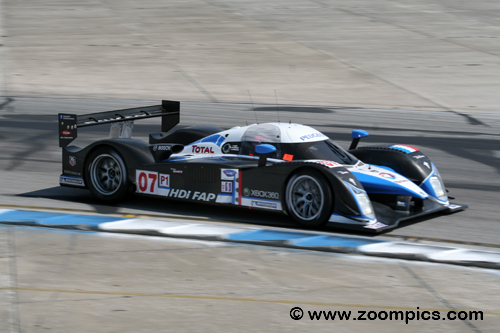
|
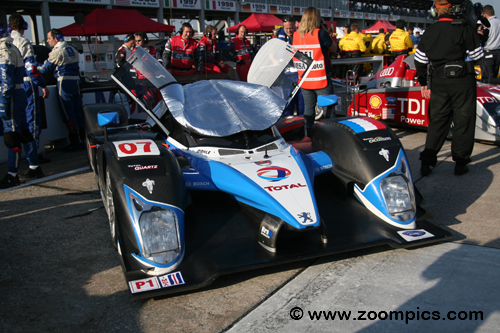
|
The suspension uses double wishbones with pushrods and rocker-arms on each corner. Rather than using conventional coil springs, the Peugeot is equipped with torsion bars. The front and rear roll bars are a blade type. A double hydraulic circuit is used for the brakes. Brake bias can be adjusted by the driver. The 908 uses vented carbon rotors – the front is 380 mm in diameter, and the rear is 355 mm in diameter. The brake calipers are one-piece light alloy. Wheels are made from magnesium. They are 13.5 inches X 18 inches on the front and 14.5 inches X 18 inches on the rear. The car rides on Michelin radials – front: 33/68-18 and rear: 37/71-18. |
| The engine is positioned mid-rear and longitudinally mounted. The motor and cylinder heads are made from machined aluminum. The pistons are made of steel. The capacity of the V12 engine is 5.5 liters. A Bosch direct commonrail injection system is used. A Bosch MS17 handles engine management. The motor also has twin turbochargers, each with a 38.3 mm air restrictor. Like their main rivals, Audi, the car uses diesel fuel. Bolted to the engine is a longitudinally mounted six-speed transmission. The transmission uses a cast aluminum case. Gear changes are accomplished through a sequential shifter. The clutch is a cerametallic multi-plate and the differential is a limited slip. The engine and transmission use Total oil products. |
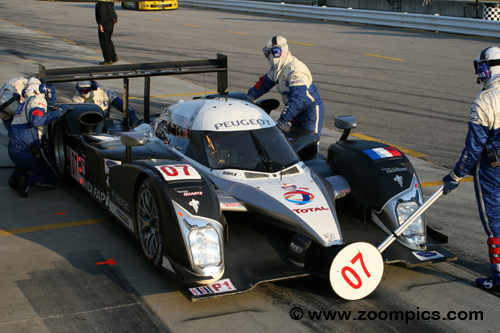
|
| Peugeot 908 HDi FAP | Le Mans Prototype (LMP1) |
|---|---|
| Monocoque | Composite carbon-fiber |
| Fuel Injection | Bosch, direct commonrail injection |
| Engine | V12 twin turbochargers with 38.3 mm air restrictors machined aluminum engine block and cylinder heads |
| Engine Management | Bosch MS17 |
| Engine Lubrication | Dry sump, Total oil |
| Engine Capacity | 5.5 liters |
| Power | Over 700 horsepower |
| Torque | Over 1,200 Nm |
| Clutch | Cerametallic multi-plate clutch |
| Gearbox | Sequential, Six-year gearbox |
| Steering | Rack and pinion power steering |
| Suspension | Independent front and rear double wishbone suspension pushrod system with torsion bars and adjustable shock absorbers |
| Brakes | Hydraulic dual-circuit braking system, One-piece light alloy callipers front and rear ventilated carbon fiber brake rotors Brake bias adjustable by the driver |
| Wheels | Magnesium forged wheels front: 13.5 X 18 inch, rear: 14.5 X 18 inch |
| Tires | Michelin radials front: 33/68-18 rear: 37/71-18 |
| Length | 4,610 mm |
| Width | 2,000 mm |
| Height | 1,030 mm |
| Minimum Weight | 900 kg + ballast 30 kilos |
| Fuel cell capacity | 81 liters |
|
The two-car team participated at Le Mans in 2007, with one car earning the pole and the other qualifying third fastest.
However, Team Peugeot's quickest entry finished ten laps behind the winning Audi R10 TDi.
The second car retired with a fuel injection problem.
Despite the disappointment of Le Mans, Peugeot 908 HDi FAP entries finished first and third in the LMP1 category of the European Le Mans Series and swept all six rounds.
Team drivers finished in the first six positions of the standings, with the leaders Stephane Sarrazin and Pedro Lamy.
|
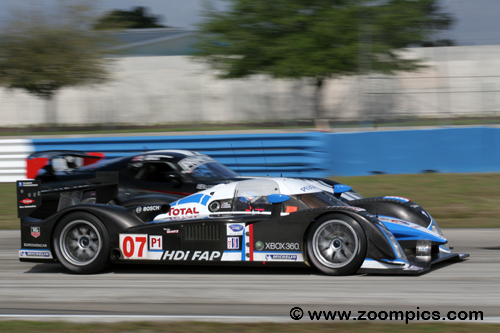
|
In 2008 Peugeot increased their odds of victory at the 24 Hours of Le Mans by entering three 908 HDi FAP. The cars topped the qualifying sheet. This year, all three Peugeots finished the race. The best result was a second place; however, they finished on the same lap as the winning Audi R10 TDi. The other two Peugeots were third and fifth. They returned to the European Le Mans Series and won four of five races. However, the LMP1 Team Championship went to Audi Sport Team Joest. Alexandre Premat and Mike Rockenfeller of Audi topped the Drivers' standings. |
| Peugeot Sport also made their first foray into the American Le Mans Series, participating in the 12 Hours of Sebring and Petit Le Mans. The entry shared by Nicolas Minassian, Stephane Sarrazin and Pedro Lamy finished fourth in LMP1 and eleventh overall at Sebring after qualifying second fastest. At Road Atlanta, the team fared much better. Minassian and Sarrazin were joined by Christian Klien. Sarrazin qualified on the pole and the team finished second overall and in class. They were just 4.512 seconds behind the winning Audi R10 TDi. |
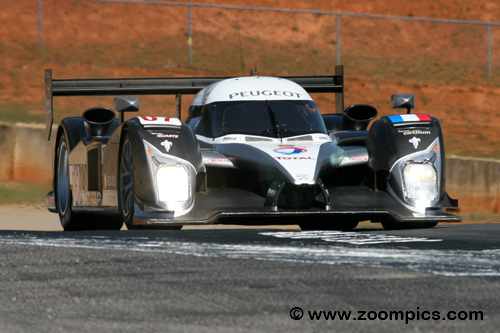
|
|
The team would take a different approach in 2009.
This year, they would compete at the 12 Hours of Sebring, 1000 km of Sp, 24 Hours of Le Mans, and perhaps additional events if victorious at Le Mans.
|
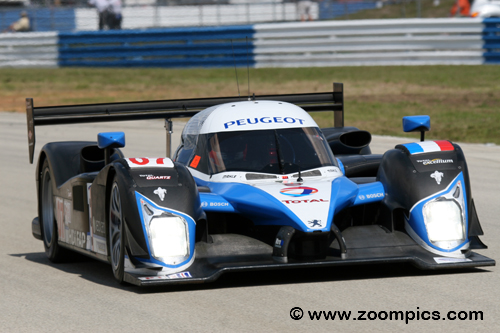
|
The first race of 2009 for Peugeot Sport was the 12 Hours of Sebring. The 07 Peugeot 908 HDi FAP was shared by Pedro Lamy, Nicolas Minassian and Christian Klein. Franck Montagny, Stephane Sarrazin and Sebastien Bourdais drove the No. 08 entry. The surprise in qualifying was courtesy of de Ferran Motorsports, who put their Acura ARX-02a on the pole. Audi Sport Team Joest and Team Peugeot Total occupied the next four positions on the grid. The de Ferran Acura gave way to the Audis and Peugeots early in the contest. The pole-sitter retired after 246 laps and was classified as a non-finisher. |
| As expected, the strategy became the focus of the race. At every stop, the Audis would change tires while Peugeot switched every other stint, which allowed Bourdais to take the lead in the No. 08 Peugeot 908 HDi; however, a spin took him out of contention. The No. 07 encountered mechanical issues, removing the car from any chance of winning the event. In the end, the No. 08 Peugeot would bounce back but finish 22.279 seconds behind the winning Audi R15 TDi of Tom Kristensen, Allan McNish, and Rinaldo Capello. The second entry was twenty-seven-laps behind the winners at the checkered flag in fifth overall and fourth in class. |
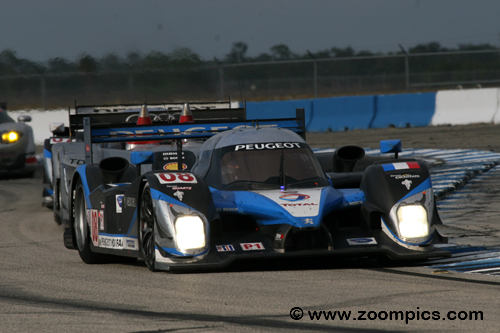
|
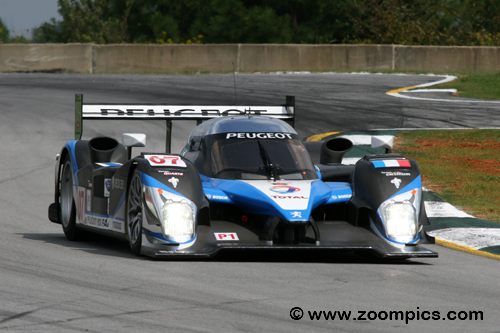
|
The next event of Peugeot's schedule was the 1000 km of Spa with two cars. The driver lineup was different from Sebring's. Piloting the No. 7 Peugeot 908 HDi FAP were Nicolas Minassin, Simon Pagenaud and Christian Klien. The second Peugeot was shared by David Brabham, Marc Gene and Alexander Wurz. Although the practice sessions were interrupted by changing weather conditions and several red-flag incidents, the team got a handle on the cars. In qualifying, the No. 7 entry was the fastest and started on the pole, thanks to Simon Pagenaud. A lexander Wurz qualified the No. 9 second quickest, just 0.026 seconds slower than Pagenaud. |
| The two Peugeots ran first and second early in the race. At the first stop, David Brabham took over the driving duties for the No. 9 908 HDi FAP. Unfortunately, Brabham made a mistake on lap 53, and there was contact between him and the Ibanez Racing Service LMP2 Courage LC75. He pitted to replace the right-side lower wishbone, which caused the team to lose thirteen minutes. For his part in the incident, Brabham received a four-minute stop-and-go penalty. The No. 7 would capture the victory, Team Peugeot Total's first since Nurburgring in August of last year. The second Peugeot would finish twelfth overall, tenth in LMP1 and seven laps behind the winners. |
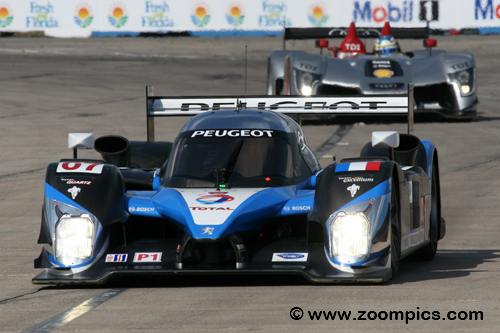
|
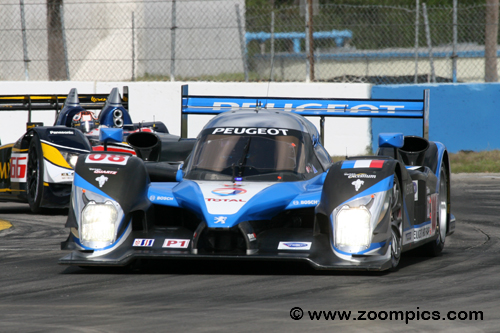
|
The team entered their most important race of the year, 24 Hours of Le Mans, with a victory at Spa. However, in preparation for the launch of the Le Mans, Peugeot had to update its cars. An ACO rule change saw the air restrictor reduced from 39.9-mm to 38.3-mm. Additionally, air conditioning was required to keep cockpit temperatures below 32C. More horsepower had to be found. The team worked with their partner Bosch to optimize injection and combustion to compensate for the loss of power. Another emphasis was aerodynamics, as the rear wing had to be smaller. Changes were made to the nose of the cars to maintain balance. The vehicles carried 30kg more weight and the fuel filler neck had to be smaller, which slowed pit stops. |
| Team Peugeot Total entered three Peugeot 908 HDi FAP. The No. 7 Peugeot would be driven by Pedro Lamy, Christian Klien and Nicolas Minassian. An all-French lineup consisting of Sebastian Bourdais, Franck Montagy, and Stephane Sarrazin was assigned to the No. 8 908 HDi FAP. As was the case at Spa, the No. 9 Peugeot was shared by David Brabham, Marc Gene and Alexander Wurz. To increase the company's odds of winning, a fourth Peugeot 908 HDi FAP was entered by Pescarolo Sport. This team was chosen based on Henri Pescarolo's background with Peugeot and his experience at Le Mans. The former Formula 1 driver had four overall wins at Le Mans and six class victories. |

|

|
As expected, the battle in qualifying and the race would be between the Peugeot 908 HDi FAP and the Audi R15 TDi. The qualifying session ended with the No. 8 Peugeot, driven by Stephane Sarrazin, claiming the pole. However, 0.762 seconds behind Sarrazin was the first of three Audis. 908 HDi FAPs occupied positions three, four and five on the grid. The final two Audis were the sixth and seventh quickest. This was the third consecutive year that Peugeot started on the However, changes to the rules meant that the fastest Peugeot was four seconds slower than last year. The top six cars in qualifying were covered by less than three seconds. |
| Early in the race, the No. 8 and No. 9 Peugeots moved into the lead and maintained a rapid pace. On the other hand, the Audi entries struggled with understeer and needed to be better prepared than Team Peugeot Total. However, contact between the No. 7 car and the Pescarolo entry resulted in damage. No. 9 would cross the finish line first after twenty-four hours of racing. One lap behind the winners were their teammates driving the No. 8 Peugeot. Despite falling to fifty-first place, the No. 7 entry battled back to finish sixth while the Pescarolo Sport team was eighth. This was the company's third victory at Le Mans, and the other two came in 1992 and 1993. |
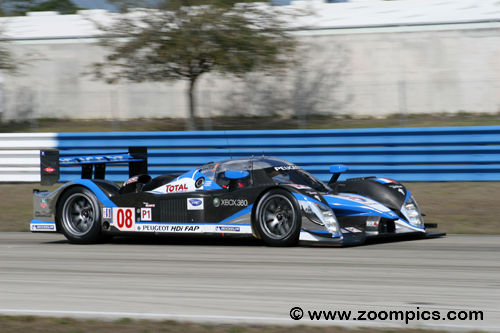
|
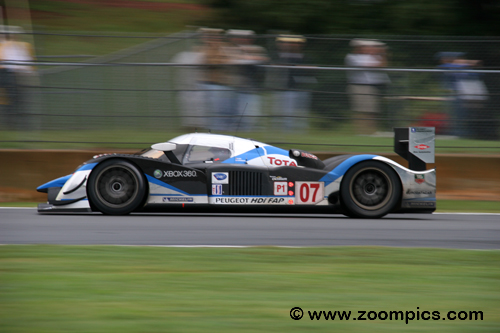
|
Bolstered by their success at Le Mans, Team Peugeot Total entered two cars for Petit Le Mans. For this race, the Peugeot 908 HDi FAP entries were in the same aerodynamic configuration as that used in the Spa 1000 km rather than the set-up used at the Le Mans 24 Hours. Regarding the engines, the units that ran on Wednesday during free practice at Le Mans were re-used without modification at Atlanta. Each engine had completed about 1500 kilometers. Driver pairings were Nicolas Minassian and Pedro Lamy in the No. 07 car, and the No. 08 car would be driven by Franck Montagny and Stephane Sarrazin. The No. 07 Peugeot of Minassian qualified on the pole. The second fastest by a margin of 0.223 seconds was his teammate, Montagny. The Audis were third and fourth fastest. |
| The Audis moved to the front early in the race and led 160 of the 184 laps. However, a spin put the Peugeots in the first two positions during a caution period. The weather worsened, and race officials red-flagged the contest after almost five hours of competition. The intention was to restart the event when the situation improved. However, that never happened and the No. 08 Peugeot 908 HDi shared by Montagny and Sarrazin were awarded the victory. Their teammates Minassian and Lamy finished in the second position. The No. 2 Audi was third and fourth was the No. 1 entry. |
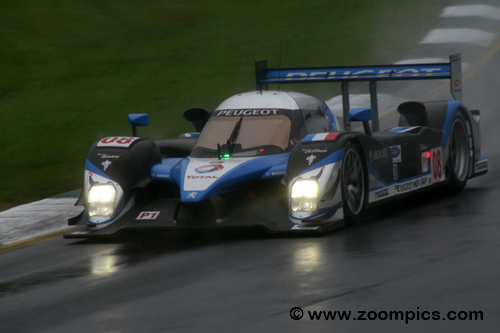
|
|
Peugeot ended the season with victories at Spa and Road Atlanta,
but more importantly, they met their prime objective, which was winning the 24 Hours of Le Mans.
Team Peugeot Total returned in 2010 and won the Le Mans Series LMP1 championship.
However, they failed to finish despite entering four cars at Le Mans.
With new regulations for the 2011 season, the Peugeot 908 HDi FAP became obsolete and was retired.
|

| YEAR | ENTRANT | NO. | DRIVER | CLASS | LAPS | POS. | CLASS POS. |
|---|---|---|---|---|---|---|---|
| 2009 | Team Peugeot Total | 08 | Franck Montagny Stephane Sarrazin Sébastien Bourdais |
LMP1 | 383 | 2 | 2 |
| Team Peugeot Total | 07 | Pedro Lamy Nicolas Minassian Christian Klein |
LMP1 | 356 | 5 | 4 |
| YEAR | ENTRANT | NO. | DRIVER | CLASS | LAPS | POS. | CLASS POS. |
|---|---|---|---|---|---|---|---|
| 2009 | Team Peugeot Total | 7 | Nicolas Minassian Simon Pagenaud Christian Klein |
LMP1 | 143 | 1 | 1 |
| Team Peugeot Total | 9 | David Brabham Marc Gene Alexander Wurz |
LMP1 | 136 | 12 | 10 |
| YEAR | ENTRANT | NO. | DRIVER | CLASS | LAPS | POS. | CLASS POS. |
|---|---|---|---|---|---|---|---|
| 2009 | Peugeot Sport Total | 9 | David Brabham Marc Gene Alexander Wurz |
LMP1 | 382 | 1 | 1 |
| Team Peugeot Total | 8 | Franck Montagny Sebastien Bourdais Stephane Sarrazin |
LMP1 | 381 | 2 | 2 | |
| Team Peugeot Total | 7 | Nicolas Minassian Pedro Lamy Christian Klien |
LMP1 | 369 | 6 | 6 | |
| Pescarolo Sport | 16 | Christophe Tinseau Bruce Jouanny Joao Barbosa |
LMP1 | 368 | 8 | 8 |
| YEAR | ENTRANT | NO. | DRIVER | CLASS | LAPS | POS. | CLASS POS. |
|---|---|---|---|---|---|---|---|
| 2009 | Team Peugeot Total | 08 | Franck Montagny Stephane Sarrazin |
LMP1 | 184 | 1 | 1 |
| Team Peugeot Total | 07 | Nicolas Minassian Pedro Lamy |
LMP1 | 184 | 2 | 2 |

| Copyright Notice: |
| All content (photographs and text) appearing on this website are the exclusive property of © www.zoompics.com and are protected under International copyright laws. The subject matter on this website may not be reproduced, copied, stored or manipulated. |